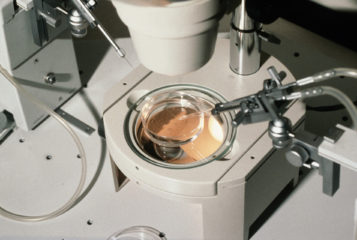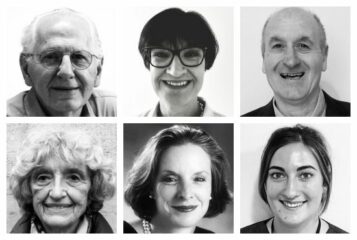The Progress Educational Trust (PET)'s Edinburgh event '40 Years of IVF: Past, Present and Future' promised to be a special one, organised as it was to mark the 40th birthday of the world's first IVF baby boy Alastair MacDonald, and it didn't disappoint.
Alastair's mum Grace MacDonald's experiences as the second successful IVF patient are not well known, and these were teased out with deft questioning from PET Trustee Professor Allan Pacey.
Professor Pacey effortlessly took the audience on a pathway of discovery from how Professor Sir Robert (Bob) Edwards and Dr Patrick Steptoe formed a collaboration, to a vision of how IVF may look in the future.
Dr Kay Elder, who previously worked with the pioneers of IVF at Bourn Hall (the IVF clinic they founded in Cambridgeshire) and who has researched the history of the field, gave a fascinating account of the work of Dr Steptoe (who pioneered laparoscopy) and Professor Edwards (who was keen to work with human material after years of mammalian research).
She told how the two met at a conference at the Royal Society of Medicine in 1968, and after discussing their work decided 'let's do this'. I wonder if they knew at that stage what 'this' was, and what it would lead to.
The challenges they faced were huge – scientifically, logistically and financially (see BioNews 954). We learned about the pivotal role that nurse and embryologist Jean Purdy (see BioNews 917) played in resolving difficulties on all of these fronts, from making sure that each weekend the car was loaded with all the kit ready to drive from Cambridge to Oldham (where Dr Steptoe worked) to setting up the first IVF lab in a cupboard.
Grace MacDonald joined in the conversation about that first rather 'homemade' IVF lab, as she recalled that she always knew when Jeanie (as she called Jean Purdy) was working nearby because the lab door squeaked.
Grace told how she had tried everything to get pregnant including tubal surgery. After reading a magazine article about Dr Steptoe and Professor Edwards' research when she next saw her gynaecologist in Glasgow she asked him about it. He hadn't heard of it, but undeterred Grace asked him to write to Dr Steptoe, and he agreed to do so if she wrote to him as well.
There was a long wait for the response as Dr Steptoe was having a double hip replacement, but eventually he agreed to see Grace, and off she went to Oldham.
She described the fertility patients as 'cuckoos in the nest' at Dr Kershaw's Cottage Hospital, which seemed to be full of old people. She described the kindness of both Dr Steptoe and Professor Edwards, and described Jeanie as a 'mother hen' poking her head around the door, giving patients the thumbs up and instinctively knowing when they needed encouragement.
When asked how he felt about being the world's second IVF baby, Alastair said that to him it was normal, but at the same time he was also proud about it. Far from being bored by these stories surrounding his conception and birth, he said he learned something new every time.
He first learned he was an IVF baby when Dr Steptoe died – he wanted to know why his Uncle Patrick and his friend Louise (Brown) were on the TV news. When Grace told him, he said: 'Mum, now I know why I am special, I am a test-tube baby.'
Alastair continues to be special. He sees himself as an ambassador for IVF and for his 'uncles' Bob and Patrick, and he described Uncle Bob as an inspiration to him.
After hearing from the MacDonalds we leapt forward to the present day and the next speaker, Dr Abha Maheshwari, who works at the Aberdeen Fertility Centre. According to the Centre's last HFEA (Human Fertilisation and Embryology Authority) inspection report, it carried out 951 IVF cycles in a single year.
Dr Maheshwari described the standard IVF cycle now, pointing out how it differed from those early days. The biggest game changer was the use of ultrasound – no need for the laparoscopies now. The freezing of embryos, so they could be used for another attempt to achieve a pregnancy, had also transformed treatment.
Sally Cheshire, chair of the HFEA, told us that IVF success rates had doubled since the regulator she leads was first established in 1991. The HFEA was the world's first fertility treatment regulator, and is widely respected to this day.
Cheshire was keen to share news of productive meetings in which she had participated in Scotland, and said how delighted she was with the NHS funding situation for IVF in Scotland and with the collegiate spirit engendered by Scotland's National Infertility Group. She also discussed how success rates in Scotland were higher than the national average, and how all Scottish clinics had hit their targets for single embryo transfer. 'If the rest of the UK were like Scotland we would be very happy,' she said.
As a former fertility patient, Cheshire acknowledged Grace's bravery in paving the way for the patients that followed. As the first chair of the HFEA to have been a fertility patient, Cheshire's determination to improve the patient's lot – whether by questioning unnecessary add-ons, or by improving emotional support – shines through.
When asked by Professor Pacey whether she thought the pioneering work of Dr Steptoe and Professor Edwards would be permitted now, she endeared herself to me by responding that there would be a PET event to discuss it.
Professor Colin Duncan, chair of the Society for Reproduction and Fertility, completed the line-up of speakers. He said that if a fertile couple were locked in a room in Edinburgh for a month and told to get on with it, there would be a 22 percent chance of a pregnancy (assuming that the couple were still talking to one another!). This is a natural conception rate.
Now, thanks to IVF, we can return a couple's fertility to slightly better than normal with a conception rate of about 30 percent. The problem is that people want and expect a much better than normal conception rate, and in his opinion this will be very hard to achieve.
Professor Duncan thought that there would not be any giant leaps in IVF success rates, but that we would just keep chipping away and improving them incrementally.
He thought that one of the priorities for research should be the ageing egg. With women having children later and later, age-related infertility is a problem that IVF alone will not solve. Groundbreaking research being conducted in Scotland – which will be discussed by the relevant researchers at PET's next event in Edinburgh – could lead the way in providing options for these patients.
At the event's conclusion, the customary fuss was made of birthday boy Alastair: presents, cakes, and everyone singing 'happy birthday'. But the star of the show for me was his mum.
As many of you will know, PET loves coming up with pithy titles for its events. We missed a trick with this one – we should have called it 'Amazing Grace'.
PET is grateful to the Scottish Government for supporting this event. A film of the event will be made available on PET's YouTube Channel in the near future.
PET's next public events with the Scottish Government in Edinburgh will be the afternoon symposium 'Revolutionising Reproduction: The Future of Fertility Treatment' and the evening discussion 'Germline in the Sand: Where Should We Draw the Boundaries for Genome Editing?'.
Both of these events are taking place on Tuesday 19 March. Find out more here.







Leave a Reply
You must be logged in to post a comment.